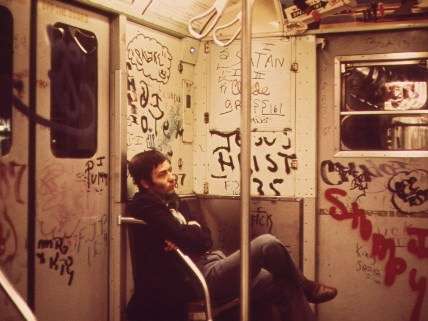"The Tyranny of Nostalgia": Landmarking Businesses Won't Preserve NYC's "Authenticity"
Professional nostalgists advocate for regulations that actually make life more difficult for small businesses.
Louis C.K. famously told Conan O'Brien, "Everything's amazing and no one is happy." He was referring to the now taken for granted technological miracles produced in the capitalist system such as plane travel and digital phones, and how everyone is miserable despite life in the developed world getting safer and more prosperous by the day.

You could say the same of the folks I refer to as "the New York City authenticity police," professional nostalgists who long for a rose-colored image of the past, and who want to preserve that image in the present by having the government freeze time so that dive bars which no longer draw a sustainable clientele can stay in business.
In a new op-ed for the New York Observer, I write:
The keepers of "real" Gotham are certain their preferred moment in history was the perfect time to be alive. And it could have lasted forever if not for you meddling uncool people. These strident nostalgists demand the charming sleaze of early Koch-era Times Square and signage from long-defunct companies, but lest you think they're hopelessly stuck in the past, they also want the safe streets, functioning subway system and smoking bans of modern-day New York. They want the grit, but not the things that create grit.
Forget the obvious contradictions that make such conditions impossible. This is a dangerous kind of nostalgia. If taken seriously, as policy rather than a cultural argument, it will hurt the very people the nostalgists seek to protect by institutionalizing rose-colored longings for the past, at the cost of the present.
Don't get me wrong, there is absolutely nothing wrong with shining a light on beloved (if sometimes forgotten) businesses that positively contribute to the unique character of a neighborhood. But too many urban preservationists fail to understand the correlation between the policies they advocate for, meant to keep failing businesses afloat, and the economic conditions those policies create, which make it harder for small businesses to remain viable in expensive cities.
I also ruffle some feathers by examining the politics of urban preservationist patron saint, Jane Jacobs:
The sign/shirt/slogan reading, "More Jane Jacobs, Less Marc Jacobs," is a popular mantra among New York's authenticity police. It refers in the former to the West Village activist who defended her beloved neighborhood from being destroyed by Robert Moses' proposed superhighway (which would have connected New Jersey and Brooklyn by way of the Village), and in the latter to the high-end fashion designer's stores.
It completely misses the point. Yes, Jane Jacobs was an urban preservationist, but she was fighting top-down government planning of what the city should look like, not advocating for it. In the book Jane Jacobs: Urban Visionary, Jacobs is cited as describing the combination of government and the private sector as a "monstrous hybrid" and likened it to organized crime. In an interview with the Toronto Standard, Timothy Mennel, co-editor of the book Reconsidering Jane Jacobs, said, "Jacobs tended to oppose the state but endorse the economy—at least local economies—making her more of a libertarian than a socialist."
Read the whole thing here.


Show Comments (20)